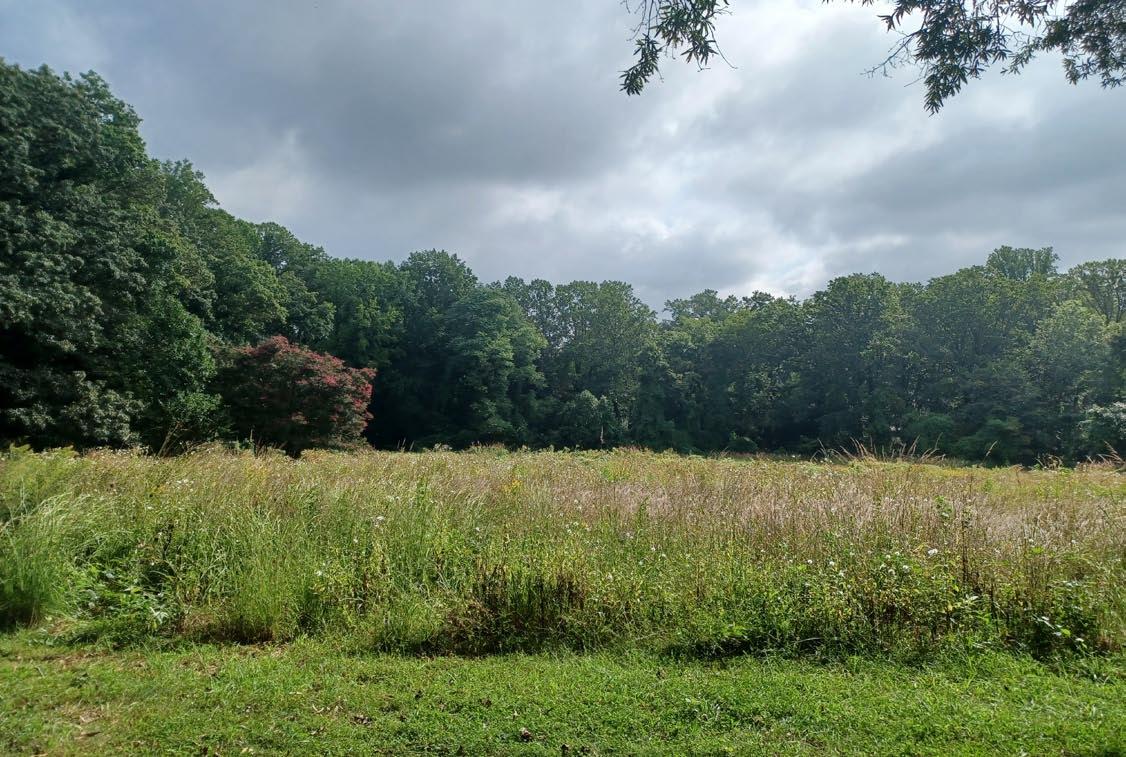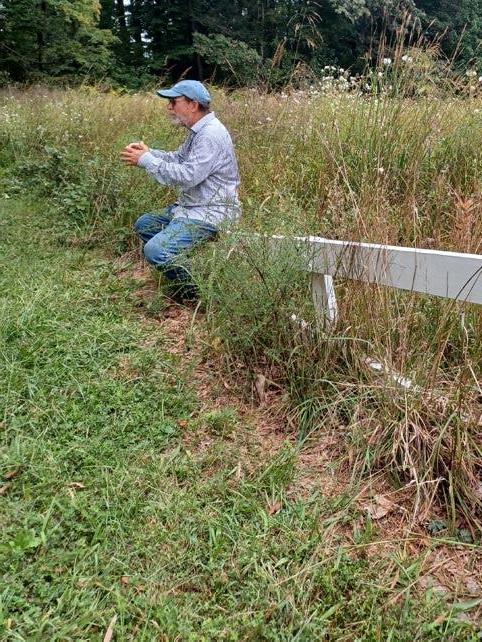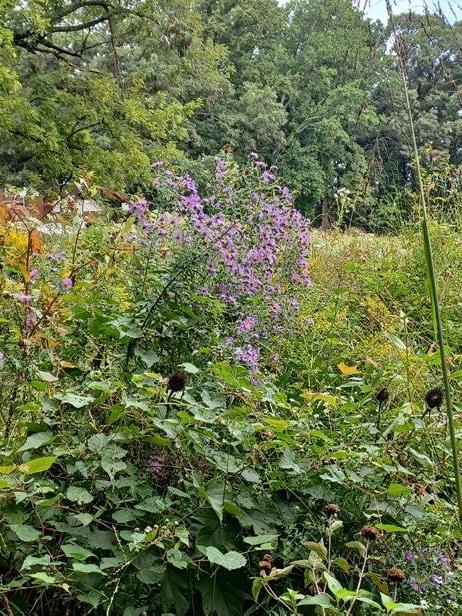
5 minute read
DAYtrip
By Charlotte Benedetto
The John C. and Margaret K. White Gardens Horticultural Park is a new and remarkable public park in the heart of suburban Fairfax County, VA, and is an unmissable stop for any native plant fanatic or meadow enthusiast. A genuinely absorbing woodland and meadow native planting site, the White Gardens sits at 3301 Hawthorne Lane in Falls Church, VA, and has the potential to become a truly great native plant garden. The White Gardens Park has a certain feature of terrain and a particular vision that provides a sense that it is not only a facility with so much happening already, but so much to potentially offer. Under the direction of site manager Judy Zatsick, I would not be surprised to see it become a significant and important native plant gardening center in the DC area similar to the Mt. Cuba Center in Hockessin, DE. On terrain already gifted with a versatile acid soil, the White Gardens Park is a former private residence that has been converted into a public park. Sitting snugly at the end of a cul-de-sac in a quiet family neighborhood, its aspect is one of quiet mystery and a unique personality. But this is not a remote homestead or a rural site—the neighbors are never more than a stone’s throw away, whether they are humans or deer. The park’s paths have a complex soil narrative, with shifting components, moisture levels, and elevations; there is so much potential here to install different kinds of native species, and to interact with the site’s ever-changing and ever-unfolding narratives of sun and moisture levels. Despite the vagaries of pokeweed, wild lettuce, and porcelainberry, this garden (and its inner meadow) is a prime site for the development and study of the native plants of Northern Virginia. Changes in elevation and sun exposure tease and ribbon throughout the White Gardens, potentially offering something for just about every kind of native plant in one site. The supreme feature is the meadow: its grassy-sweetness everywhere, and its clouds of seed releasing in billows when the wind blows like confetti. Eversquabbling jays, clouds of mayflies like tumbling glitter—the meadow pulses out a sensual appeal, pulling and drawing visitors hither and thither, drawing the eye to each surface, species, and texture change. It’s easy to become lost in the White Gardens’ many transitions and colors. It is not, however, easy to become physically lost in this tidy and compact suburban park. A chorus of children and leaf blowers often drone along with the crickets and songbirds. Curvaceous with hills, microclimates, and unfolding slopes and flat areas, a small hardwood stand, or miniature upland graces a sort of paddock or open yard near the White Gardens residence. An understated vintage brick cottage—the former White residence— radiates the unique local glamour of mature buildings in this area, somehow having avoided the destruction of the developer’s wrecking ball. The Whites lived in this brick cottage at the top of a curved and sloping crunchy-gravel driveway; small shrubs and a gentle shadow of rhododendron jungles behind the house form an attractive, wet-looking green mass.

A gentle rise forms a vista onto and through the huge planted meadow itself, its moist borders and mowed bottom area bordering woodland, thickets, and suburban scrub at the bottom of the slope, and slaty, rocky, humid woodland and grassy-sweet, fast-draining hillsides. These garden rooms run the gamut, with all the local microclimates packed in together. The White Gardens Park has a surprisingly lively personality that pulls you in—a sort of conversation through many changes in terrain, elevation, vegetation, and view. The meadow itself is compelling and impressionistic, with cloudlike masses of form and color. Reminiscent of a moor or a heath, the meadow contains a crowd of native plants. Grassy odors, suburban breezes, butterflies, and songbirds entertained a recent group as landscape designer and native meadow expert Larry Weaner advanced us through the White Gardens meadow one species at a time. Each plant has a nuanced and organized role in this cast of characters. Some might say Weaner (pictured at right) is sort of the “Elvis” of native meadow design, thanks to being the author of 2016’s trailblazing work, Garden Revolution: How Our Landscapes Can Be a Source of Environmental Change. The meadow at the White Gardens is a Weaner-directed production, with both seeded plants and seedling plugs installed by volunteers starting around 2015. “When you show up in a place like this that was covered almost 100% with porcelainberry, and the second most-numerous plant was mugwort, you know these plants are going to be up against some rough-andtumble players,” said Weaner. The White Gardens meadow plants are a living blueprint for how to out-compete the porcelainberry and English ivy choking most DC-area backyards. “Obviously, we need to go in and as best we can, get rid of that stuff before we start. We’re not just going to seed into a sea of porcelainberry and expect success to happen.” An understanding of the different competition levels of native plants is the arcane knowledge essential here. “Number one, we need to pick a high level of competitive species, because we expect a high level of weed pressure, and number two, those species that we do select have to be on an equal competitive footing,” Weaner explained, “I’m going to use a lot of very competitive species, and I’m not going to bother with less-competitive ones, because even if I keep the weeds out, the more-competitive things I planted will weed out the less-competitive things.” Planning a native garden like the White Gardens meadow is technical, but also a “little dance,” as Weaner put it. Volunteers at the White Gardens get experience in observing this ballet between the desirable high-diversity/low-competition plantings and the lowdiversity/high-competition plants needed to acculturate the site. As a designer, “you’re putting things together on an equal competitive level, and what level you’ve selected is in part based in part in how much weed pressure you expect to see,” Weaner said. “The worst is over,” and the maintenance is significantly lower than the initial installations. As for the seeds we saw floating all over the meadow from wild lettuce? “The best strategy to control that is do nothing.” There is a vision and hope for the future in the White Gardens.
John C. and Margaret K. White Gardens is at 3301 Hawthorne Lane, Falls Church, VA. Parking is limited. To volunteer, contact Fairfax County Parks at www.fairfaxcounty.gov/parks/residentcurator-program/white-gardens. Note that the Fairfax County Park Authority is accepting applications (through November 10, 2021) for curatorship of the historic White Gardens. The curator will guide its development from a private residence and garden to a public garden. o
Charlotte Benedetto is a writer, artist, and gardener living in Great Falls, VA. She is enrolled in the Northern Virginia Community College horticulture program and is an intern this fall with Washington Gardener.










